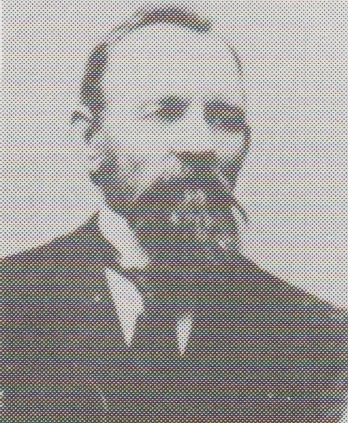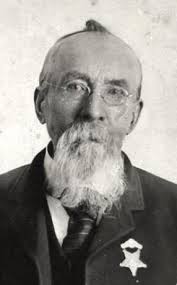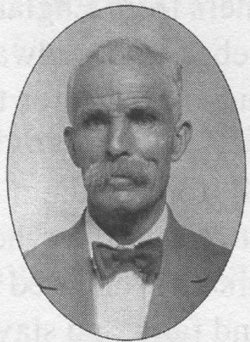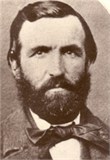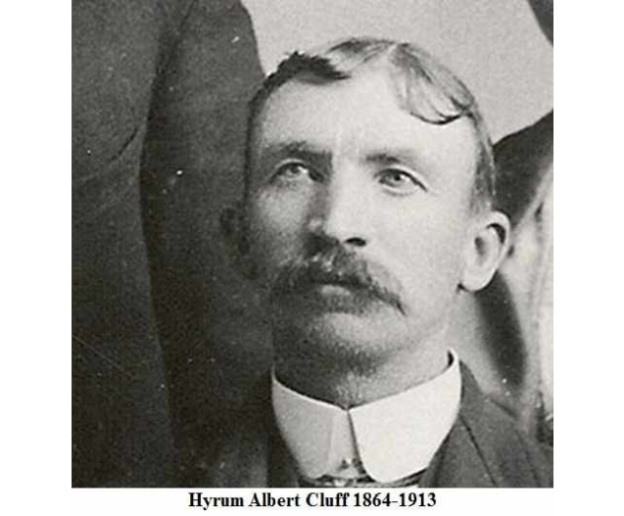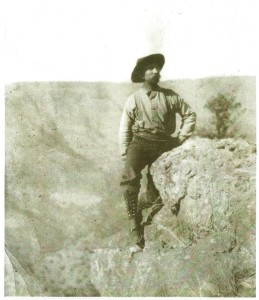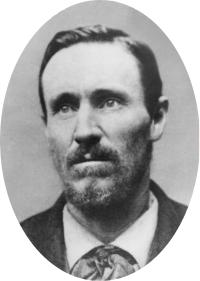Jens Christian Larsen Breinholt
1841-1914
I was born on September 8, 1841 at Vinding Land on the beautiful shore of Vejle Bay, about 8 miles from the city of Vejle, Jylland, Denmark. My father’s name was Lauers Jensen and my mother, Ane Sophie Nielsen.
My parents belonged to the Lutheran protestant church and in accordance with the customs of denomination, I was at the age of about one and one-half months taken to the church, sprinkled with water which act was called baptism by that church, christened and given the name of Jens Christian Lauersen. The reason why I don’t bear exactly the same name now will be explained later.
My parents were both conscientious, God-fearing people, honest, upright, and industrious. They were kind and loving toward their children of which they had 10 in number—five boys and five girls. I was the first child. Having been reared by googly parents I presume that I naturally inherited the same tendencies. Especially did I at an early age acquire a reverence for God. In my early youth in mingling with people of the world, I did not exhibit my inward convictions in outward manifestations and during the years of my minority I sowed a good deal of wild oats.
By the time I had grown to the age of 20 I had become somewhat disgusted with the religions of the day, deeming them in most cases only hypocrisy. I consequently took no stock in them.
At the age of 11½ I was hired out to work for my living. The nature of my work was tending horses, cows, and sheep. As I remember, the wages for my first summer’s work was less than five dollars (American money) plus by board. During my early years I hired out to various farmers and also acquired the customary schooling. In the spring of 1856 when I was 15 years old, I commenced as an apprentice with my father to learn bricklaying and plastering, which occupation I followed more or less as long as I stayed in my native land and also when I came to America.
Inn the spring of 1861 I was introduced by a chym to aman by the name of Niels Jensen, a bricklayer. This man was a Mormon, a fact which my young fried cunningly concealed from my knowledge until I had bargained with him. Had I known before hand that he wa a Mormon I would have had nothing to do with him. On telling my friend so, he assured me it wouldn’t have made any difference, for though a Mormon; he was a pretty good fellow.
Here came the turning point in my life, for although I had been reared in a Christian church by Christian parents and Christian ministers, I did not know what a true Christian was until this man told me. It did not take very long after my acquaintance with Niels Jensen, through conversing with him on religious matters, that I was convinced that Mormonism was true. I did not however become humble enough to receive baptism until 1863 when on the 11th day of January I was baptized in a broke on the borders of the city of Vejle by Elder Anders Hansen and confirmed a member of The Church of Jesus Christ of Latter-day Saints.
The conference held in the fall of 1863 in Vejle I was ordained a teacher and sent on a mission to the Horsens Branch to labor under the direction of Gustav Pegan. I was by him ordained a Priest. Shortly after, I was ordained Elder and set apart to preside over the Horsens Branch. On account of the war between Prussia and Denmark, my work as a messenger of the Gospel did not last long as I, being 22 ½ years old was eligible to be drafted into the army. Therefore, the spring of 1864 I was released from my mission with the privilege of emigrating to Zion. I have built myself of the opportunity. My father, although not a member of the Church at the time was liberal with means to enable me to go. On 4 April 1864 I bade goodbye to my parents, brothers and sisters in Nebsager Mark in on 6 April, I bade adieu to my native land, Jutland, and proceeded on until we arrived at Liverpool, England.
On 28 April 1864 I boarded a large sail ship called the Monarch of the Sea in company with about 1,000 Saints. The captain in charge was John Smith. We found ourselves pretty low crowded. Especially did we experience a great deal of inconveniencing the cooking department and it was chance work if we got anything to eat. It took about 35 days from Liverpool to Castle Garden, New York.
We proceeded on by boat and trail until we landed on the west bank of the Missouri River at a place called Wyoming, where we laid in waiting about a week before the ox trains from Utah arrived which were to take us across the dreary plains. Instead of going with the church teams, I am for other men decided to go as teamsters for a man named Soren Christofferson from Manti so we would not be in debt to the Church for passage.
Her company numbered eight souls with six wagons and 20 yolk of cattle. During the summers of’64,’65 and ’66, the Indians were very hostile on the plains and we were greatly exposed to being massacred by them, being so if you traveling alone and guarded. But God preserved our lives many of our cattle down the plains. When we got to Fort Bridger we were compelled to leave two of our wagons there.
I enjoyed the trip across the plains very much, enjoying good health all the way. We saw no Indians and they did not molest us but many depredations were committed on the plains that summer. We entered the valleys of the mountains by way of Provo Canyon 13 October 1864 and proceeded right onto Manti.
My first job in my adopted country was digging the seller for a Miller who live south of Manti. The next hired out for a year to Peter Rasmussen, Bishop of Salina, Sevier County, Utah.
Manti on 29 October and traveled on foot towards my new home. Went about four miles south of Manti, I retired to a secluded place and kneel down before the Lord in secret prayer and thanksgiving and to him who preserve me over land and sea to the land of Zion and the home of the Saints. I asked my heavenly father on this occasion to bless me with a gift of speedily acquiring the English language and the Gila my lungs which for several years before leaving Denmark had been very weak and at this time would often bleed profusely. I prayed for my mother and father, brothers and sisters, all of whom were left in my native land. I asked God to lead them all into the fold of Christ. I asked him to bless me and all my labors and travels in the land of Zion. I covenanted anew that if he would hear and answer these my humble petitions that I would serve him all days my life. I can say to the praise of the name of God that he has bestowed upon me every gift I asked on this occasion.
I soon acquired the use of the English language, the Bishop taking great pains to instruct me. While living at Salina, the Black Hawk War broke out in April 1865. There were several men killed which stirred up great resentment amongst the settlers. I rode bareback on a pony to Glenwood, 15 miles away to warn the settlers of that vicinity that the Indians were on the rampage. I carried a small rifle already loaded as there was no place to carry a ramrod. I returned safely quite late in the day.
During my stay at Salina I heard news about a girl, Joanne Hansen, whom I had known in Denmark. I had shunned her on account of it being rumored that she was going to become a Mormon. She did join the Church and came to Zion with her brother. She was now living alone out in circle Valley since her brother had been killed by the Indians. I renewed my acquaintance with her and after the necessary proposals, we were married by Bishop William Allred on 13 February 1866 and I moved to Circle Valley and join together in building a fort for protection against the savages. I moved our house into the floor for protection and we lived there until the early part of June. Then my order general Daniel H. Wells, the place was vacated. We left our land, crops and all we never returned.
We made our about it Manti for a few weeks and then moved to Ephraim, Sanpete County, where we lived in a little log house. We both worked in the harvest fields cradling and binding wheat and oats to help us acquire a few of the necessities of life. On July 11, 1867 our first son was born, but he died when 11 months old in 1868. Grasshoppers ate most of the wheat crop this year and I spent much of my time in fighting these destroyers. There was however enough we took bread the people and my family did not suffer.
This fall I had the pleasure of meeting my brother Peter and my sister Ane and her husband as emigrant Saints to this land.
This fall, 1868, a call was made by President Brigham Young for volunteers to go work on the Union Pacific Railroad in Weber Canyon. My brother and I and a great many more went, but it was cold and the work was dangerous, being in a a deep stone cut called Slate point near the 1,000 mile tree West of Omaha, Nebraska. The majority the men soon went home, many of them not clearing expenses. I stayed until spring and then left without my pay afterwards and afterwards had considerable difficulty in getting it and finally had to take it mostly and goods.
In February 1869 I was ordained a Seventy of the 47th Quorum of Seventies by Thora Thurstesen. In the fall of 1869 I went to Salt Lake to meet my parents and family and learn my mother had died while crossing the plains.
In 1870 I took my wife to the endowment house in Salt Lake City to be sealed for time and all eternity. With my wife’s consent in full approval I married a young lady from Laaland, Denmark, named Christine Larsen and she was also sealed to me in the Endowment House. She bore me two daughters, one of whom died in childhood of Diphtheria. My wife Christine also died in April, 1873.
In December 1873 a call came from the First Presidency of the Church for masons and laborers to go work on the St. George Temple. I felt that my duty to go. Thus with approval of my family I left them on 1 December and joined a company of 25 men and boys who arrived in St. George after very difficult weather and bad roads. I worked on the St. George Temple at this time a little over three months giving my time as a free will offering for the erection of the house of the Lord. In the middle of October 1874 I again went to work on the St. George Temple and worked until the stonework was completed which was in March 1875. My wife Christiana whom I had married 30 March 1874 in the Endowment House, accompanied me and also my little daughter Sophia. I then returned home to see from where lived for several years and where several of my children were born.
The spring of 1879 I went to work on the Manti Temple cutting stone in the winter and laying it in the summer for seven continuous years. My wages were $3.50 a day.
Well any from, I and my brothers and my father desired to have our name changed. The reason for doing so was because there were so many families named Larsen living any from that our mail matters went to the wrong persons, and also because the various spellings are names since coming to America. We petitioned the legislative assembly of the Territory Utah asking the privilege of adopting the name of Breinholt as a surname for ourselves and posterity. The privileges granted us by the last legislature in which polygamists were allowed to serve in 1882.
I bought some property in Redmond, Sevier County and move my families there in 1886 and tending to settle down to farming, but I was unable to live in peace on account of the pressure from the US Marshall and forcing the Edmunds law and the charter amendment which required a man to abandon all but one wife. For conscience sake it could not abandon my wife Christiana and her five little children and thus I was tried and found guilty of the crime of unlawful cohabitation. I served hundred five days in the state penitentiary along with many great and good men of the Church. I felt proud that I had been numbered among so many staunch man and true, who were willing to suffer imprisonment for the sake of their families rather than to make the unholy promise to obey the law made by man on purpose to persecute the Mormons.
In 1889 I was asked to take charge and conduct the stonework of the Stake Tabernacle being built in Richfield, so after I put in my spring crop on the farm in Redmond and leaving it to my sons to care for, I began work on the Tabernacle and continued to work there until November 1891.
During this time I had made plans to leave the United States and traveled down to old Mexico and thus in connection with Simon Hansen of Mayfield and Soren Thyggersen of Ephraim, I chartered a Rio Grande freight car to be loaded at you from 24 November 1891. My wife Johanne and family prefer to stay with the home in Redmond and this was a sad parting. I loaded some furniture, provisions, one cow, a team, and some farm implements in the boxcar along with those of my brethren and I wrote on this car being allowed free passage for taking care of the animals.
I arrived at Deming, New Mexico on 3 December to join my family and friends who had arrived by passenger train. From Deming we were to proceed the remainder of our journey by our teams. We also were to receive pass papers from the Mexican Consul and have everything classified, numbered and listed in shape to passed the custom house at Ascensión. This proved to be a very tedious and laborious ordeal, besides its being expensive. On 9 November we started for old Mexico and had an uneventful journey over the barren country to the first Mormon settlement, Colonia Diaz. On 17 December we passed the last guardhouse at Carlito’s and proceeded on to Colonia Dublan, arriving after dark.
On 18 December 1891 we drove onto Joseph Jackson’s flour mill near Casas Grandes, Chihuahua. Here we were made welcome by William Morley Black and his wife who was a sister to my wife Christiana. The following day we pitched our tents beside their house which was a lumber building about 12’ x 14’. The ground was so dry and Rocky that it was difficult to drive stakes in it. We were now thankful to our heavenly father that we had reached the end of our journey without any sickness or harm. The year 1891 was a very dry year and it was difficult to get feed for our livestock and also flour and other food was very scarce. Shortly after the new year I got to build a dry stone wall for brother Jackson around an enclosure of his home. With the help of my two small sons we earned about $3.00 a day.
Shortly after my arrival in Mexico, Brother Black moved to the mountains and he sold me his house. I proceeded to tear it apart and moved it on to a 25 acre tract of farmland in San Jose that I had bought for Brother Jackson. I pitched my tent in the riverbed ownership trees until I got the house built. I continue to work as a stonemason for Joseph Jackson for about two years until his new grist mill was completed.
My family and I became members of the Colonia Dublan Ward, Juarez Stake. We hear joined in the activities of the Ward in my children attended school here until 1899. I did amazing construction on several of the early built homes in Dublan. To mention a few: Helaman Pratt, Gaskel Romney, Lewis Cardon (Louis Cardon)and many others.
Note: After 1894, this journal history was never completed by J. C. L. Breinholt in his own handwriting, but there were many important things that are necessary to record about his activity and honorable life.
My father, J. C. L. Breinholt, with his wife Christiana and their children on their farm in San Jose, Mexico. Here he cared for his farm and always worked at his trade of masonry and stone cutting. He almost always more to and from work every day, sometimes a total of ten miles.
In the fall of 1894 while at San Jose, Christopher B. Heaton was operating a molasses mill at the adjoining farm. One day some Mexicans were seen loitering around. After Heaton had left for the night the Mexicans returned and rolled barrel of molasses to the pummis pile and covered it with pummis (the pulp of the sugar cane) in preparation for coming back the following night. He decided to try to have them arrested. He went to the officers of the law and asked them to come and arrest these natives when they came back, but he was disappointed as the authors never came. He attempted to handle the situation alone and concealed himself to wait for them to return. Shortly after dark they arrived in ox team and wagon on which the load of the barrel of molasses. When they started to leave, Heaton stepped out and ordered them to stop. They were prepared for trouble and shot Mr. Heaton through the shoulder, then beat him to death of the club. They took his gun robbed him of his watch. Breinholt heard the shot and knew that there was trouble. He immediately sent his two oldest boys to go after the horses in the field instructed them to go to Dublan for help. He then went on foot to the scene of the tragedy. The murderers had left and dragged tree limbs behind the wagon to try to cover up their tracks. These thieves were apprehended but turned free in a day or two without being punished.
In the spring of 1899, J. C. L. Breinholt moved his family to Colonia Juarez. While living in Juarez he built some of the brick and stone houses of that area including one for Anthony W. Ivins and a large stone house for John W. Taylor.
In Juarez and took pride implanting choice fruit trees and other things. At the time they had no culinary water except from the irrigation ditch. An early morning chore, while the water was fresh and clear, was to fill the water barrels for household use. J. C. L. Breinholt was called to serve a mission for the Church in his native land, Denmark. He left November 5, 1900 and return from this mission November 22, 1902. He enjoyed excellent health even though he was at the time 60 years of age.
On account of the revolution in Mexico during the years 1910-1912 the people in the Mormon colonies were counseled by Church Authorities to leave Mexico until the trial was over. Many never returned. J. C. L. Breinholt and his family returned to Redmond, Utah leaving everything they owned except what could be packed in a couple of trunks and a suitcase.
It was difficult to leave his home at age 72 and face the necessity of taking charity from friends and relatives, although he was very happy to see them all again. During the two years that he lived at Redmond he spent considerable time fixing fences, gates, and other things for his eldest son who had remained in Utah and made the family welcome and provide for them with a log house. The summer carrying it was made quite comfortable and here Father and Mother Breinholt lived out the remainder of their lives. He died November 5, 1914 being sick just five days with pneumonia contracted while helping harvest beets. She died just a month later on December 7, 1914 and was buried beside him. J. C. L. Breinholt was honest and forthright man in all his daily dealings with his fellow man. He was kind intemperate in his disposition. He was neat, clean, and systematic in his everyday habits in person. He observed the Sabbath Day and was regular with family prayers, and his blessings on the food. He paid an honest tithing and he was liberal in his contribution to the Church and the communities in which he lived. He kept his homes and lands in good repair and his orchard in garden were always well cared for. His manners were outstanding and he enjoyed the food that was prepared for the family. He was very particular about his appearance and kept his sandy-colored, medium length beard clean and trim. His penmanship was excellent and he was good in mathematics and tried to improve his education by reading a great deal. He lived the health rule of “Early to bed, early to rise, makes a man healthy wealthy and wise.”
Although he never acquired worldly goods in excess of the moderate living he left a good name for his 18 children and the numerous posterity that survived him.
Condensed from the personal Journal of Jens Christian Larsen Breinholt, and completed by Oliver C. Breinholt, son.
Stalwarts South of the Border Nelle Spilsbury Hatch page 63

